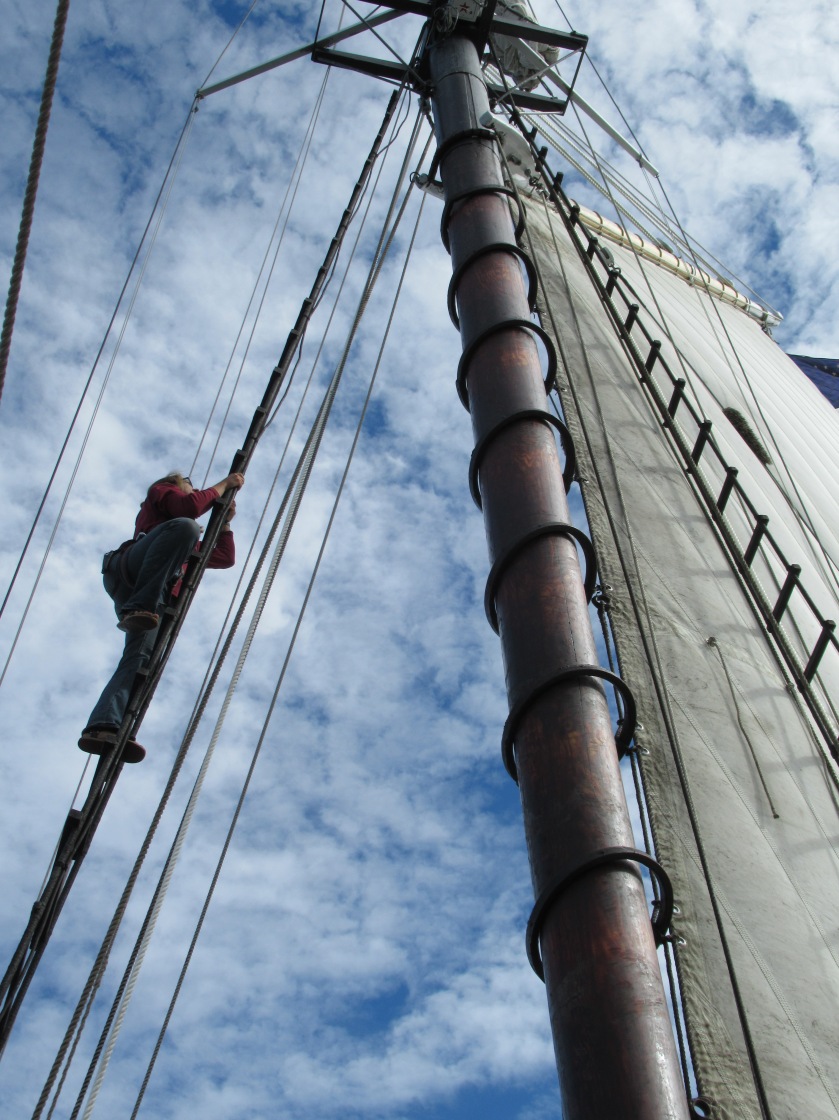
Rain spattered the deck and canvas awning of the schooner. Kerosene lanterns hung fore and aft, their glowing circles of light spreading into the surrounding darkness. The wooden hull groaned and creaked, and the ship rocked gently on the tide, rubbing against the dock as if protesting the lines tethering her to shore. With such a lullaby, I fell asleep easily our first night on board the Lewis R. French, the oldest two masted schooner in the United States.
I woke to the smell of fresh baked muffins from the galley where the cook baked them from scratch on a wood stove. A heavy fog surrounded the ship as we hoisted the sails and eased out of Camden Harbor into Penobscot Bay. In spite of the fog, there was enough wind that we put a reef in the mainsail.

Out in the bay, the fog was even thicker. First mate Darcy sat at the bow with a hand-cranked fog horn. She blew a long and two shorts every few minutes as a signal to other boats. We passed another schooner, emerging from the mist like a ghost off the starboard bow. Occasionally the vague shape of a rocky island slid by, and we heard the muffled clang of a buoy’s bell, warning of reefs. Captain Garth used GPS to navigate, but in the fog it was easy to imagine a time when such luxuries were unknown.
In many ways, sailing the French now is like reenacting the past. The ship looks and handles much the same as she did in 1871 when she was first launched. For a hundred years, she worked along the Maine coast hauling many different kinds of cargo from fish to Christmas trees. In 1971, she was rebuilt to carry passengers on pleasure cruises. Here we see the real differences between past and present. Though they are tiny (there is barely enough room for one person to stand beside the bunk with the door closed), each cabin is a model of design ingenuity, using every nook and cranny for storage, and providing far more space than any sailor would ever have. Each cabin also boasts running water and electric lights, additional luxuries earlier sailors wouldn’t even dream of.
In 1992, the French was designated a National Historic Landmark. Though she is home-ported in one place, the French is unusual in that she is a moving landmark. In our four-day trip, we anchored in Smith Cove, off Burnt Island, and in Rockport Harbor before returning to Camden. As an historic landmark, the French is important not just because of where she is, but what she is: a 147-year-old schooner that still relies on human hands to raise and trim the sails. Even the anchor is raised manually with the aid of a windlass. She’s not just a place, but an experience. Sailing with only wind for power in fog, rain, or bright sunshine evokes a time-gone-by when life was slower. (Slower, but not easier. A sailor’s life was hard, cramped and cold, alternating between periods of intense activity and boredom.) We saw porpoises, seals, cormorants and eagles, just as sailors have done in these same waters for more than a hundred years.
On the last day of our cruise, we sailed into Rockport Harbor. The wind had died, and we tacked back and forth across the bay to ease closer in, moving at one knot or less instead of the four to five knots we’d sailed the day before. As we lowered the anchor, a sliver of blue sky spread out under the clouds. Gradually the clouds blew off, until by late afternoon, the sun shone in a clear blue sky. Patches of bright red and brilliant orange dotted the hillsides as the trees began showing their fall colors.
That night, as the French swung slowly on her anchor, rocking with the tide, we sat up on deck and saw the Milky Way splashed across a clear sky. With the waves lapping at the hull, and the stars twinkling overhead, I could almost hear the voices whispering from the past, tying this place now to the same place long ago.
Learn more at Lewis R. French Schooner website


What is a “mackeral sky”?
LikeLike
A misspelling for mackerel. It is the thin, wispy clouds covering the whole sky, with a pattern sort of like the scales on a fish (ie the mackerel).
LikeLike